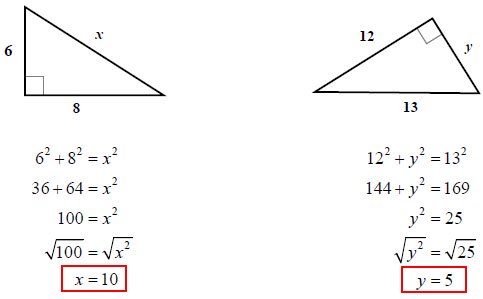
 |
|
|
|
The Pythagorean TheoremThe Pythagorean Theorem, a2 + b2 = c2, is probably the most famous and well-known formula in all of mathematics.
First of all, the pythagorean theorem can only be used in right triangles. In all triangles there are three sides; in a right triangle, two of those sides are known as the legs and the other side is known as the hypotenuse.
The hypotenuse is the largest side of the triangle, which is always across from the right angle. The other two sides are the legs and it doesn't matter which one is which. Take a look at the examples below...
Notice the arrows above pointing across from the right angle to the hyptoenuse. The hypotenuse is important because it is the c value. The legs represent the a and the b values: again, it doesn't matter which one is which. In a sense, the theorem is really...
Take a look at the examples below. Again, notice how the hypotenuse is always substituted in for c (the right side of the equation).
It's as easy as that! Congratulations, you now know how to use the pythagorean theorem. Return to more free geometry help o r visit the GradeA homepage for other free math help resources.
|
| . | ||
| Home │ Site Search │ Math Help Blog │ Help Keep GradeA Free | |
Written by Team GradeAmathhelp.com, all rights reserved. | ||


